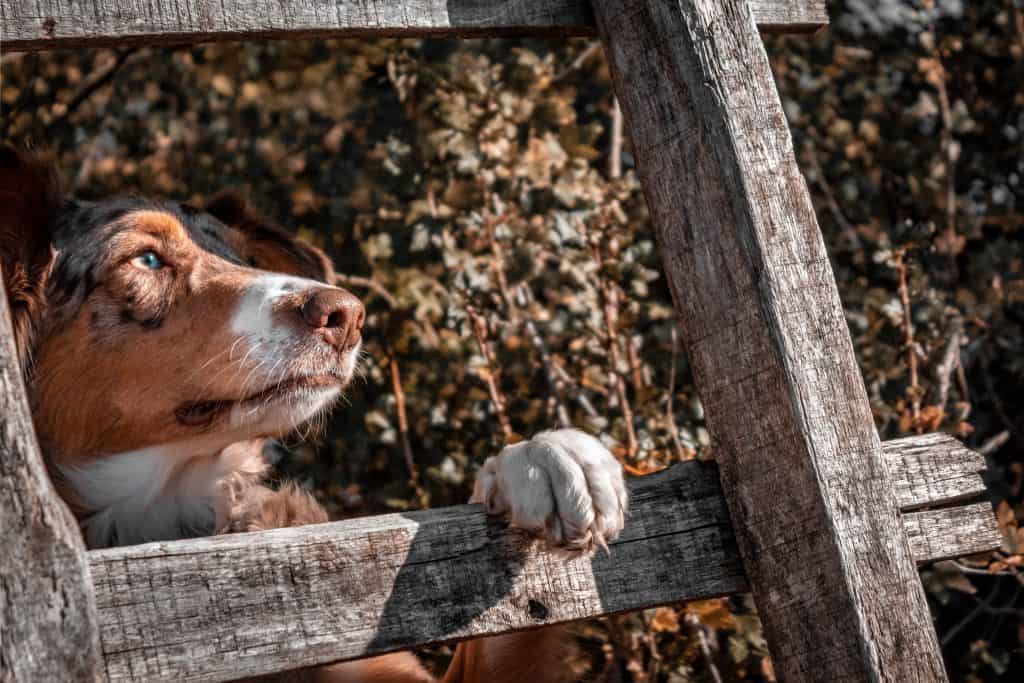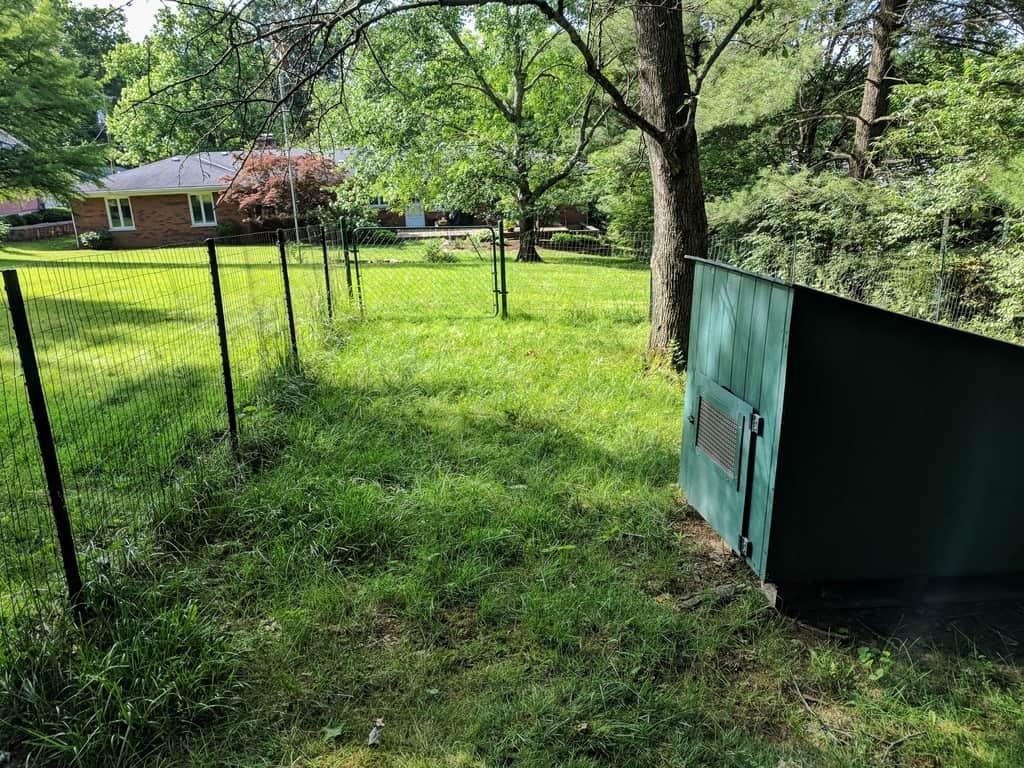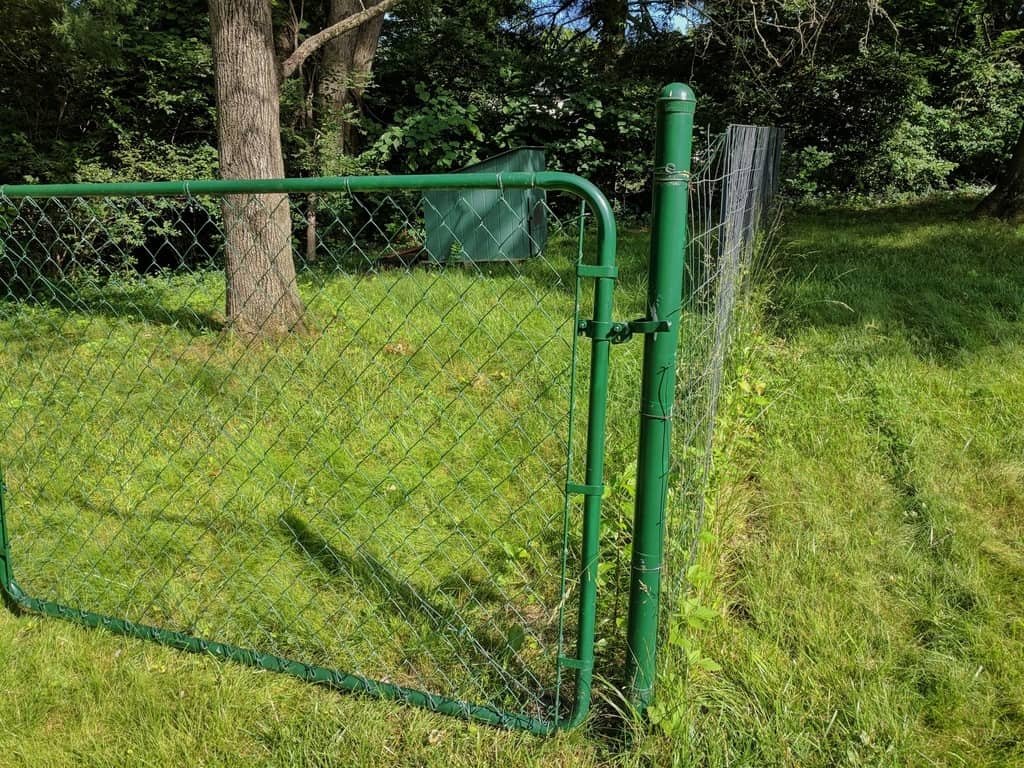As an Amazon Associate we earn from qualifying purchases.
Are you tired of constantly chasing after your furry friend every time they decide to run off into the sunset? As much as I love my dogs, their adventurous spirits can sometimes be quite the pain.
Building a DIY dog fence can not only provide a sense of security for your pet, but it can also give you peace of mind knowing they are safe and sound. Learn how to build a dog fence, whether a simple wire dog fence or even just a temporary fence for dogs.
I will outline four creative and practical DIY dog fence ideas that you can easily build at home, without breaking the bank.
Contents
How to Build a DIY Dog Fence

Your focus should ideally be on building a DIY dog fence that is simple yet durable. Yes, you want the cheapest dog fence, but you also want something easy to install and maintain. Broadly speaking, there are four types of containment systems available that I’ll review:
- First, the traditional DIY fences, made of wood or a metal fence. These are rather common and easily recognizable.
- Second, invisible fences. These have quite a few aesthetic appeals but also have a few risks built in.
- The third is the hybrid system, with some features of a traditional homemade wire dog fence and some that of an invisible one.
- The final, perhaps my favorite, is DIY affordable dog fencing made from deer netting.
Having said all this, there are thousands of fences available catering to a wide range of budgets, dogs, fencing philosophies, property types, property sizes, and your personal taste. In this article, I will focus on the most inexpensive dog fence ideas.
Dog Fence Ideas
How do you determine which of the four DIY dog fences to go with? Here are the considerations you should look at:
- The first consideration is obviously the cost to purchase, install, and maintain. Fence costs can add up quickly, but most of the cost is in hiring someone to build and install it for you. If you’re willing to construct a DIY privacy fence for dogs, you’ll save a lot.
- The second consideration is the height of your DIY fence. Carefully research what your specific dog breed is capable of jumping over. Additionally, make sure to take into account what you know about your specific dogs. You don’t want to go to all the effort of building a fence, only to find out after the fact that it is 1ft too short.
- Lastly, take an honest stock of how much time you have. I recommend choosing one of the DIY dog fence ideas, but it does take time to build. The average time required to construct such a privacy fence of about 200 yards is ten to twelve hours.
If you are ready to spend about 3-4 hours each day, you can build a beautiful looking DIY dog fence in about three days. However, depending on the size of your project and your skill level, building time may vary widely.

4 Dog Fence Options
Here is a rundown of the most common wood fence ideas and systems for building an inexpensive dog fence.
1. Traditional Wood or Metal Dog Fences
Traditional fences are made of wood or metal and are generally considered to be good fences if you want a standard wooden or metal dog fence that will be really effective. But, there are some considerations associated with such a project.
Upsides
A fence made of traditional wood or metal is strong, sturdy, and protective. Aside from your dog digging under the metal fencing or jumping over it, it will be durable and last a long time.
A wood or metal dog fence is also very stylish and will add a nice touch to your house’s yard.

Downsides
For starters, these wood and metal fencing options are the most expensive style of a dog fence. While you can save some in the way you build your project, it will still add up quickly. Also, the labor involved is fairly time-consuming.
How to Build
You’ll need wood or metal fence posts, fence boards, and 2×4 support boards, along with screws. I’ll outline the fencing process to create a construction out of wood, but you can substitute the fence materials for a metal dog fence fairly easily as well.
- Determine the height you want your fence, and ensure your fencing posts are tall enough. You’ll want to sink them so that 33% of the total post height is in the ground. So, an 8ft post will drop 2.5ft into the ground, leaving you with a privacy fence post that is 5.5ft high. This will work for a 6ft high fence.
- Plan your fence by staking out your corners and marking every 8ft for your posts. Check to ensure your angles are correct with a plumb line and a T-square.
- Dig your holes for the privacy fence posts. This will take a decent amount of time, and you might want to research tools to help you dig faster, such as a post-hole digger, especially if you have hard ground.
- Fill the holes with concrete and install your fence posts. Some recommend going even further by adding gravel below the concrete, but I don’t find that necessary. When the concrete sets, fill in the holes with dirt.
- Add a plumb line or masons line where your support boards will run across. I recommend at the top of your fence post and a second line 12″ off the ground. You can also use a laser level if you have one.
- Install your 2×4 support boards, and then screw the privacy fence boards into your support boards. Use a table saw as necessary to refine the width of the edge fence board.
You will want to stain or finish your wood fence to help it last longer. At this point, you should have a fence that is beautiful while also standing up for a long period of time.

2. Invisible Wireless Dog Fences
Invisible wire dog fences refer to the containment system where you don’t see a physical wire fence. The way it works is that you place wire fencing around the area where you intend to keep your dog safe.
There is a transmitter box in the wire fence, usually located in your house or garage, and an electric collar that is attached to the dogs. Every time the dog nears the wire fence boundary, a warning beeps to keep your dogs safe and away. If the dog persists in moving beyond the wire fence, the dog is shocked with a mild static delivered through the collar.
Invisible wire fences may sound like the greatest wire fence there is. But, it comes down to your philosophy on how comfortable you feel with buzzing your dog with static when it crosses the wire fence boundaries you intend for them to stay in.
While some think it’s perfectly okay to use mild shocks to train the dogs and keep their pet safe, others are horrified at the idea. They think it’s inhumane and may have lasting effects on dogs, including being in a constant state of fear.
Other than ideological grounds, invisible wire fences are reported to be effective in about 70% of cases. What is more, the wire fencing on the ground cannot distinguish which side of the fence the dogs are on.
In case a dog decides to take the electric zap and jumps over the wire fencing, it will be zapped every time it wants to return. This may make the dog actually go further away from home.
Upsides
These fence products are a good suggestion for someone looking for easy dog fence ideas. They are amazingly straightforward and fast to install, especially in comparison to building your own fence. In addition, you don’t notice an invisible fence because, well… it’s an invisible fence!

Downsides
It isn’t 100% secure, as there are always stories of dogs getting through it. There are other issues, such as technological failures, that make this a risky solution if your small dog is especially prone to escaping.
Set Up Process
Go buy your invisible dog fence, and follow the instructions for installation. It’s that simple!
If you do want to go the electric or invisible fence route, you may want to review a few systems available before you zero in on any specific type.
Whatever system you choose, you will have to install the system and then take some time training your small dog to get used to it.
It’s best to keep your grass trimmed and well-kept with a lawnmower during this time to ensure that sight is clear and your dog can visibly see his boundaries. It usually takes about two weeks to train the dog to associate crossing the boundary with the unpleasant zapping.
Once trained, you can then test the electric correction system and enjoy leash-free play with your dog.

3. Pallet Dog Fences
If you’re looking for the best dog fence ideas to build by yourself, then the first two suggestions aren’t really going to work. However, an easy way to try out your DIY skills in the backyard is by building a picket fence from pallet wood.
A pallet fence is very similar to building a traditional wood structure but easier than a picket fence. You can save by picking up the pallet wood for very little or free. Pallets are durable, inexpensive, and more versatile than metal.
The biggest advantages of pallet fences are that the best dog pallet fences are very affordable, they are easier to build than a picket fence, they are sturdy, and they can be moved easily.
However, keep in mind that a pallet fence may be too low for some dogs. Apart from that, it may not look as good as a store-bought picket fence, and it may be vulnerable to termites and pests, so it’s harder to keep your dog safe. But, overall, they are a good and durable solution if you are searching for really affordable fence ideas for dogs.
Upsides
A pallet dog fence is the ultimate in how to build a fence for your dog. Plus, if you’re into the rustic DIY look, then you’ll really love the design and feel you get from this pallet project.
Downsides
The wood is not high in quality, and the finished product can look low end. Moreover, depending on your dog and pallet, the fence might not be tall enough.
How to Build
Follow the same instructions for building a traditional wooden fence, but instead of adding 2×4’s and fence boards, use pallets. Make sure to take account of the pallet width measurements and use those as you set your wood posts.
If you’re really looking for the best dog fencing ideas, this is a better option than chain link fences. You can add some class to the finished project by painting or finishing the wood.

4. Deer Netting Dog Fences
I saved my favorite dog fence option for last. Using a flexible fencing material like deer netting or garden netting gives you the ultimate flexibility, it’s better than chain link and also saves you expenses in the process.
Upsides
A fence made of this flexible material is mobile, meaning that you can take it down for winter and put it back up in the summer. It is a lot more affordable because the bulk of the material is made from affordable deer netting. It is also very easy to install and do yourself.
It is also a lot easier to install than a chain-link fence. Cutting chain link fencing is difficult and requires specialized tools.
Downsides
The deer netting is not a solid material – it is made of plastic, unlike a chain link fence. Thus, a crafty or persistent dog might be able to dig under it, or even go through it, something harder to do with a chain link fence. Depending on your preferences, this style of fence might not be as stylish and good looking in your yard as you’d prefer or as reliable as chain link fences.

How to Build
Depending on how large of an area you are building a DIY dog fence for, this is a relatively easy project to do in the afternoon. You’ll need deer netting or garden netting rather than chain link to span the circumference of your fence area. You’ll want to pick up or rent a post digger for the install. And, you’ll need studded t-posts, zip ties, and garden stakes.
- Start by installing the t-posts with the post driver, placing them 4 ft – 5 ft apart.
- Roll the netting out on the ground by the t-posts, leaving 4″-6″ of netting to go “below” the t-post and be anchored into the ground.
- Attach the netting from the top and work your way down, using the zip ties to fasten the netting to the t-post. Use cable ties instead of zip ones for added stability.
- Once you reach the bottom, roll the remaining netting inwards, towards the inside of the fenced area. Fasten the fencing into the ground with the garden stakes (anchor pins for added stability). Use 3 per section.
Final Thoughts
As long as you don’t have a persistent dog that likes to escape, this is a fantastic option for an inexpensive dog fence.

How Much Does It Cost to Build a Dog Fence?
The cost of a dog fence depends on the materials you use to build with.
- Pallet wood can usually be obtained for free, so the cost is very minimal. You’re only paying for the chain link or fence posts if you use them .
- Wood panel dog and chain link fencing usually costs between $6-$10 per square foot, with most of the cost going into the posts, chain link and fence panels.
- Electric dog fences can vary dramatically in cost. Usually, they will start at around $1,000 for the wire fencing, materials, chain link and collar. Depending on your square footage, they can go up from there.
- DIY dog fence from deer netting typically costs $2-$4 per square foot and is so affordable.
Obviously, these are just rough estimates, but they should give you a good fence idea of how much each fencing type will cost you.
How Can I Improve My Dog Fence?
When you already have your fence built, you may think about adding some improvements to make it even more useful and dog-friendly. Check out my suggestions!
Dog Fence Windows
Many people think that a traditional wooden chain link fence is the best choice because it provides the highest level of privacy. However, dogs may be very curious about what is happening on the other side, and it would be more fun for them to have some view.
For this reason, it is certainly an excellent idea to add a dog fence window, especially in the case of a small yard or one neighboring the sidewalk. They are not hard to make, as all you need is usually just a piece of metal mesh or a small hinged door.
They can have various shapes – circles, trapezoids, or long rectangles will not only be a fantastic observation point for your pet but also it will enhance the visual design of your fence. Just remember to make sure to get rid of any sharp or hard edges and adapt the hole to your dog’s head size!
Digging-Under Prevention
The role of this kind of fence is to allow your dog to have a lot of fun outside and stay safe at the same time – you certainly do not want your pet to escape outside of it, as it may be lost or get harmed. Therefore, you should add a special barrier such as chicken wire preventing your dog from digging his way out to the other side, especially if you happen to have a tunneling breed.
To do that, you can use, for example, a gate plate or a net designed for chicken wire coops rather than chain link. Apart from making it harder for your dog to get out, it will also prevent rodents from getting in!
Why Should I Have a Dog Fence?
You may not be convinced why you should build a dog fence in the first place if you regularly walk your pet a few times a day or even take it to your running sessions. It is certainly an excellent fence idea for every dog owner living in a house because the more fresh air exercise your dog has, the better. You can find some reasons for that below!
Slower Aging
Unfortunately, I can’t entirely stop my four-legged friends from getting older and older. Nevertheless, the same as in the case of humans, getting a lot of exercises helps to slow this process down and keep your dog fit and sharp. What is more, thanks to the proper amount of physical activities, it is possible to keep your dog healthy and ward off certain age-related diseases.
However, it should be adjusted to the dog’s age – senior ones still need to remain active, but not to the same degree as when they were puppies. It is recommended to consult your veterinarian about the best amount of physical activities for a dog of a particular age and breed.
More Healthy Joints
With safe and age-adjusted exercise, your dog’s joints will be in better shape. Namely, your pet will have a healthy weight, so there will be less pressure on the joints. Apart from that, it provides better joint lubrication, at the same time making the supporting muscles stronger. A sedentary lifestyle is as bad for your dog’s body as it is for yours!
Less Anxiety
If you provide your dog with space for exercise, you will contribute to lowering its anxiety. Again, it works similarly as in the human organism – physical activities make the endorphins kick in, and the feelings of restlessness and anxiety noticeably become less noticeable. Dog owners who do everything they can to keep their pet safe and fit are less likely to see a chewed-up couch at home.
Stronger Bond
With a special place for some leash-free fun together, you will be able to create a stronger bond with your dog. You can keep all the toys there, like balls or frisbees, and always easily grab them and start the playtime. You will not have to walk anywhere away, but just go outside your house and have some nice time in the fresh air that will do good to both your and your dog’s health and make you even closer friends.
Improved Safety
The playtime with your dog will not only be easier but also safer thanks to fences that look great. Namely, you will be sure that if you accidentally throw a toy too far, your little friend will not be able to chase it, suddenly running to the street where it could be hit by a car or another vehicle.
Conclusion
The bottom line is that the type of fence you choose is completely dependent on your budget and the space within which you intend to contain your dog. You should not give up the idea of building fences that look great simply because you are afraid it will be too expensive – it is a project definitely worth taking up because it will contribute to enhancing both your little friend’s health and safety, and it is not hard to narrow down the costs!
If you are seriously interested in building a dog fence, first decide on the type. Then, apply some of the ideas outlined above. It completely depends on your goals, your timeline, and your budget.
If the lowest cost is the thing you are most concerned about, then you should go for a DIY dog fence made from an inexpensive material, such as wooden pallets, chain link or deer netting. A traditional wood fence will probably be the most decorative (but it may depend on the personal taste), and an invisible solution will take the least time and effort to apply, although it may cause some ethical doubts. The choice is yours!


Keep ԝorking ,great job!
Thanks for the advice for building a dog fence. You mentioned that invisible fences could actually be really easy to install. I’m interested to learn if it could take a few days to install or if it could be much faster than that.
Hi Taylor, invisible fences typically take under an hour to install (depending on how large your yard is). Out of all the options we listed, that is by far the fastest.